
ACT Science Practice Test 43
Thời gian làm bài: 1 giờ
Đề thi nằm trong bộ sưu tập: Tuyển Tập Bộ Đề Thi Đại Học Hoa Kỳ (ACT) - Có Đáp Án Chi Tiết
Hãy bắt đầu chinh phục nào!
Xem trước nội dung:
Students conducted experiments to determine what factors affect the period of a pendulum. A pendulum is a swinging weight, or bob, attached to a string (see Figure 1). When released from an angle, a pendulum will move back and forth. One complete back-and-forth movement is called a period.
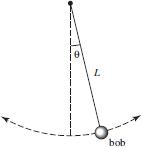
Figure 1
Three variables may affect the period of a pendulum: swing amplitude, measured as the angle at which the bob is released; the length of the string; and the mass of the bob. Students created pendulums by attaching a string to the ceiling and then tying a bob onto the other end of the string. They conducted three experiments. In each experiment all variables except the one tested were kept constant.
Experiment 1
In this experiment students varied the mass of the bob. Bobs of 20g, 100g, and 200g were tested for three trials each. The string length was 1m and the amplitude was 45 degrees. The results are shown in Table 1.
Table 1

Experiment 2
The second variable tested was amplitude. Bobs were dropped from 15-, 45-, and 75-degree angles for three trials each. The string length was 1 m and the bobs used were 100 g. Figure 2 displays the average results.

Figure 2
Experiment 3
Next the students tested the effect of varying the string length. Strings of 1 m, 0.6 m, and 0.3 m were tested in three trials each; 100 g bobs were used and the amplitude was 45 degrees. The results are displayed in Table 2 and Figure 3.
Table 2

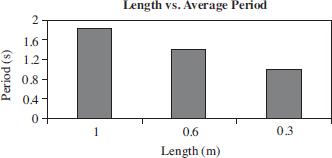
Figure 3
Based on the results of Experiment 1, the average period for a bob of 100 g was:
1.79 s.
1.83 s.
1.89 s.
1.91 s.
If an additional trial had been conducted in Experiment 3 with the length of the string being 1.4 m, the average period would most likely have been:
2.21.
1.75.
1.33.
0.87.
For each trial in Experiment 1, as the mass of the bob increased, the time of the period:
stayed the same.
increased.
decreased.
increased and then decreased.
Based on the information presented in Figure 2, which of the following pendulums would have the longest average period? Assume that the string length and bob weight are equal.

Pendulum A
Pendulum B
The average period would be about the same.
It is impossible to determine from the information given.
In Experiment 3, Trial 2, how long did it take the pendulum with the string length of 0.6 m to complete one back-and-forth movement?
1.06 s
1.44 s
1.47 s
1.84 s
Which of the following variables was NOT tested during the experiments conducted by the students?
Mass of the bob
Length of string
Size of bob
Swing amplitude
Scientists conducted a series of experiments to determine the effect of changes in temperature on the intertidal rocky shore crab, Petrolisthes granulsus (P. granulosus). Several fitness-related traits, such as body size and reproductive capacity in P. granulosus individuals from three sites were compared after the crabs were exposed to various temperatures. In addition, metabolic rate experiments were conducted to determine the energetic cost associated with crab exposure to high temperatures.
Table 1 displays the temperatures (°C) used in the experiments. Thermal category TC1 refers to the maximum temperature registered at each site, while TC2 refers to the average of maximum temperatures recorded every day. The Control thermal category is defined as the average temperature experienced by the crabs during the acclimation period.
Table 1

Figure 1 displays the average size (cephalothorax length) of P. granulosus in the 3 populations, while Figure 2 displays the average egg volume in the 3 populations.
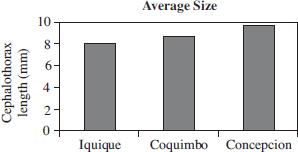
Figure 1
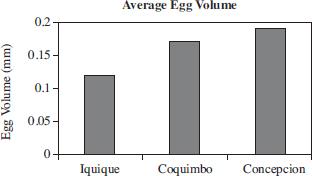
Figure 2
Figure 3 shows the average standard metabolic rates (SMR) of male crabs from the 3 populations exposed to 3 thermal categories.
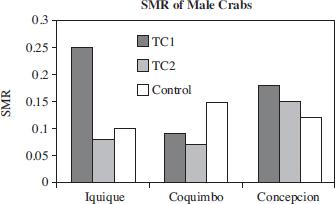
Figure 3
According to Table 1, crabs from which site were exposed to the highest temperatures during the experiments?
Iquique
Coquimbo
Concepcion
Crabs at all of the locations were exposed to the same maximum temperatures.
Based on the information in Figure 2, the average eggs of crabs from the Coquimbo site were found to be closest to which size?
0.1 mm
0.17 mm
0.2 mm
0.25 mm
According to Figure 3, adult male crabs from which category were found to have the highest average standard metabolic rates?
TC1 from Concepcion
Control from Coquimbo
TC1 from Iquique
TC2 from Concepcion
Based on the information provided, which of the following best describes the effect that average maximum temperature has on the average size of the crabs?
As the average maximum temperature increased, the average size of the crabs stayed the same.
As the average maximum temperature increased, the average size of the crabs increased.
As the average maximum temperature decreased, the average size of the crabs decreased.
As the average maximum temperature decreased, the average size of the crabs increased.
Suppose the scientists had measured the average egg volume of crabs in the control groups. Based on the information in Table 1 and Figure 2, the average egg volume of crabs at the Concepcion site would have been closest to:
0.05 mm.
0.1 mm.
0.2 mm.
0.3 mm.
The scientists started this experiment with the theory that crabs exposed to higher temperatures would develop higher standard metabolic rates. Do the results of the experiment support this theory?
Yes. The crabs at Iquique in the thermal category TC2 were exposed to the highest temperatures and were found to have the highest SM
Yes. At all locations the crabs from thermal category TC1 were found to have the highest SM
No. At all locations the crabs from thermal category TC1 were found to have the lowest SM
No. The results were mixed. At two locations the crabs from thermal category TC1 were found to have the highest SMR, but at one location the crabs from the control group had the highest SM
When introduced into H2O, many solid substances are able to dissolve, or disperse evenly throughout the solvent. Salts have been found to dissolve easily when introduced into H2O, since they readily dissociate to yield ions that may interact directly with H2O. Molecular compounds, on the other hand, do not dissolve as easily, since their interactions with water typically do not permit ionization, the physical process of converting an atom or molecule into an ion by adding or removing charged particles such as electrons or other ions. Two experiments were conducted to better understand the solubility of salts and molecules in water at various temperatures. The solubility, S, was measured as follows:
S = (msub) / (mH20)
where msub was the mass of the substance dissolved in water, and mH20 was the mass of the water itself. △S, or the change in solubility (from 0℃), was calculated in the experiments for three salts and three molecules with increasing temperature. The mass of water was held constant at 100g for each of these experiments.
Figure 1 shows the results of comparing the solubilities of three salts with increasing temperature, while Figure 2 shows the results of comparing the solubilities of three molecules with increasing temperature. Molecular masses (MM) are shown for each substance.
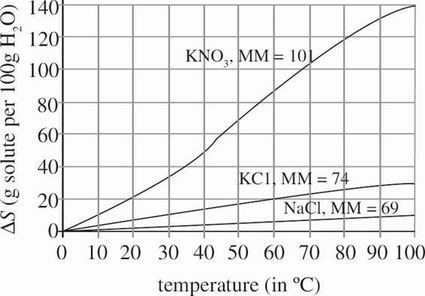
Figure 1
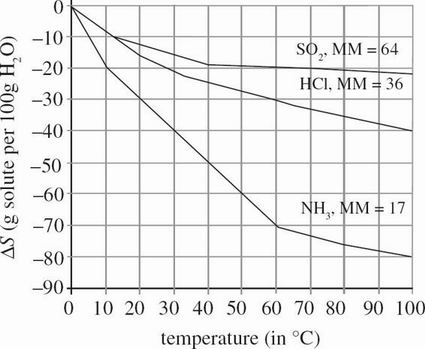
Figure 2
Based on Figure 1, at 40℃ as the molecular masses of the salts increase, the △S:
decreases, because a greater mass of substance dissolves in the same mass of water.
decreases, because a smaller mass of substance dissolves in the same mass of water.
increases, because a greater mass of substance dissolves in the same mass of water.
increases, because a smaller mass of substance dissolves in the same mass of water.
Consider the trials represented in Figure 1 that occurred at 60℃. As the molecular mass of the substance decreased, the observed △S:
increased only.
increased, then decreased.
decreased only.
decreased, then increased.
If an additional trial had been done in which KCl dissolved in H2O at 102℃, while it was still in aqueous form, the △S most likely would have been:
less than 25.
between 25 and 35.
between 35 and 45.
greater than 45.
According to Figure 2, when NH3 was added to water at 20℃, the solubility of the resulting solution:
increased, because △S was positive.
increased, because △S was negative.
decreased, because △S was positive.
decreased, because △S was negative.
Based on Figures 1 and 2, which of the following combinations of solute and temperature at a known mH2O would produce the greatest increase in solubility?
CH4
NaF (salt, MM = 42) at 40℃
CH4
NaF (salt, MM = 42) at 80℃
Recombination of genes is usually associated with the sexual reproduction of cells, or meiosis. However, it can also occur when cells that undergo asexual reproduction, or mitosis, need to be repaired, such as after radiation exposure. This repair process, known as homologous recombination, aligns two copies of the same double strand of DNA, one with the error and one without. As seen in Figure 1, correct genes are transplanted from the correct strand to the one with errors (genes with errors are represented with a *).
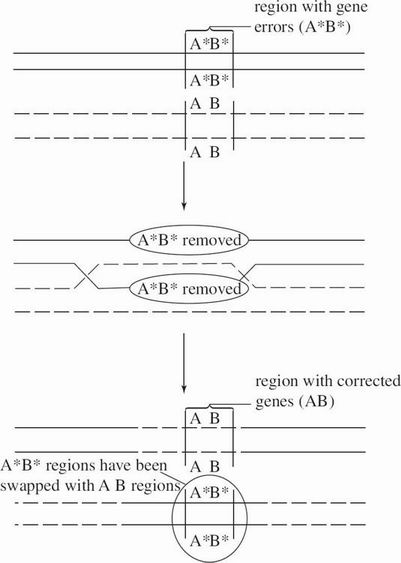
Figure 1
The activities of some genes have been found to promote homologous recombination (HR). In an experiment to quantify the genetic control over HR, 4 scientists measured the frequency of HR per hour over a 24-hour period in isolated connective tissue cells from rats placed in growth media. They then lysed the cells, separated out the entire protein content, and used gel electrophoresis to count the amount of protein present in the cells (see Figure 2).
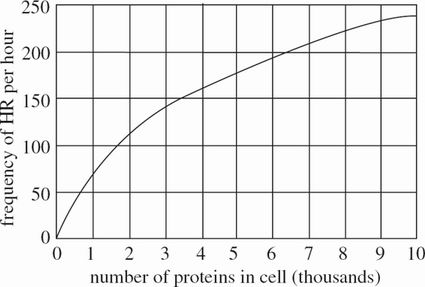
Figure 2
These scientists noticed that only a few specific proteins appeared to be responsible for promoting HR, and labeled the genes encoding them as W, X, Y, and Z. They engineered cells to express combinations of two active genes and recorded the HR. They then analyzed the DNA content of the lysed cells and calculated distances between four genes that encoded the relevant proteins (see Table 1).
| Table 1 | ||
| Genes | HR (events per hour) | Distance between genes (centimorgans) |
| W and X | 75 | 20 |
| X and Y | 125 | 30 |
| W and Z | 60 | 15 |
Each of the 4 scientists then proposed individual models for the positions of the genes they studied, taking into account the findings in Table 1. Each model shows where genes may be located along a strand of DNA (see Figure 3). Each model correctly assumes that the lengths of the genes are insignificant compared to the length of the DNA.

Figure 3
A final experiment showed that rat connective tissue cells in which genes W and Y were active had an HR frequency of 45 times per hour.
All 4 models agree on the distance between which of the following pairs of genes?
Genes W and X
Genes W and Y
Genes X and Z
Genes Y and Z
According to Figure 2, if some of the connective tissue cells had a protein content of 3,500 molecules per cell, the HR of these cells is most likely closest to which of the following?
50 events per hour
100 events per hour
150 events per hour
200 events per hour
If Scientist 2's model is correct and an additional gene, Gene V, is 10 centimorgans from Gene X and 15 centimorgans from Gene Z, then Gene V is most likely between:
Genes W and
Genes W and
Genes X and
Genes X and
The result of the final experiment studying the distance between Genes W and Y is consistent with models proposed by which of the following scientists?
Scientists 1 and 3
Scientists 1 and 4
Scientists 2 and 3
Scientists 3 and 4
Based on the information provided, HR would occur when connective tissue cells are exposed to:
growth media.
sexual reproduction.
asexual reproduction.
X-rays.
Which scientist's model proposes that Genes Y and Z are separated by 65 centimorgans?
Scientist 1's
Scientist 2's
Scientist 3's
Scientist 4's
Genes A and B are separated by 10 centimorgans on a chromosome. An organism has alleles A and B* on 1 chromosome and alleles A* and B on the homologous chromosome. If a single HR event occurred between these 2 genes as shown in Figure 1, the genotype of Genes A and B for the 2 chromatids involved in the crossover would be:
AB and A
AB and A*B*.
A*B and AB*.
A*B* and A*B*.
Xem thêm đề thi tương tự

12 câu hỏi 1 mã đề 1 giờ
214,128 lượt xem 115,283 lượt làm bài

24 câu hỏi 1 mã đề 1 giờ
219,431 lượt xem 118,132 lượt làm bài

26 câu hỏi 1 mã đề 1 giờ
219,200 lượt xem 118,020 lượt làm bài

22 câu hỏi 1 mã đề 1 giờ
219,715 lượt xem 118,293 lượt làm bài

12 câu hỏi 1 mã đề 1 giờ
218,852 lượt xem 117,831 lượt làm bài

24 câu hỏi 1 mã đề 1 giờ
219,338 lượt xem 118,090 lượt làm bài

24 câu hỏi 1 mã đề 1 giờ
218,445 lượt xem 117,614 lượt làm bài

22 câu hỏi 1 mã đề 1 giờ
208,273 lượt xem 112,133 lượt làm bài

29 câu hỏi 1 mã đề 1 giờ
215,740 lượt xem 116,158 lượt làm bài
